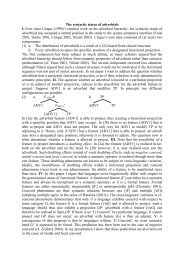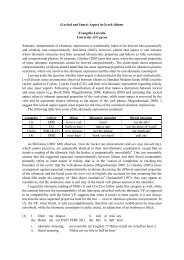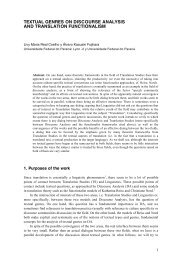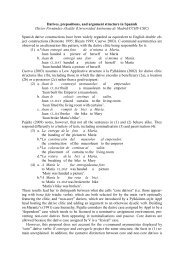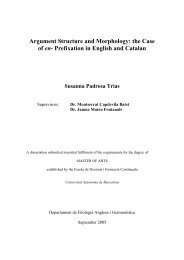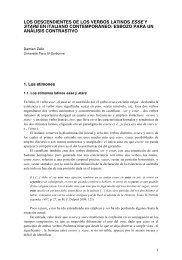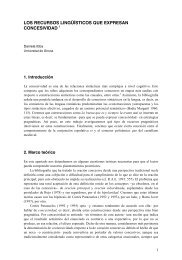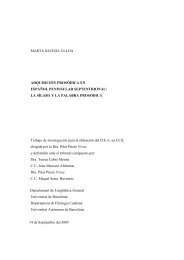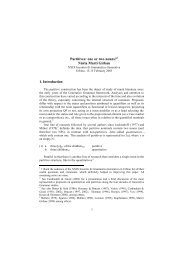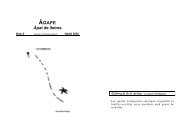- Page 1 and 2:
Jaume Solà i Pujols Agreement and
- Page 3 and 4:
List of errata 1. Most significativ
- Page 5 and 6:
Table of contents Acknowledgements.
- Page 7 and 8:
4. CP I-subjects and Small Clauses.
- Page 9 and 10:
I wish to express my gratitude to t
- Page 11 and 12:
Chapter 1 Introduction The present
- Page 13 and 14:
1. Aims and Scope of this Thesis Th
- Page 15 and 16:
why infinitives in NSLs allow long
- Page 17 and 18:
2.2. Subject Inversion Subject inve
- Page 19 and 20:
Focus, which suggests this is a Foc
- Page 21 and 22:
Thus the examples in 0 seem to indi
- Page 23 and 24:
c. Comprarà el menjar en Joan aque
- Page 25 and 26:
(10) a. Ha anat a casa en Joan Has
- Page 27 and 28:
(13) Passives: a. Han estat posats
- Page 29 and 30:
an AP, PP or NP predicate. As befor
- Page 31 and 32:
to such a conflict, subject inversi
- Page 33 and 34:
degraded constructions when the req
- Page 35 and 36:
2.2.5. Floating Quantifiers Koopman
- Page 37 and 38:
I will adopt the view that FQs unde
- Page 39 and 40:
2.4. The Split INFL Hypothesis and
- Page 41 and 42: (38) Infinitives: a. No cal (?*semp
- Page 43 and 44: Chapter 2 Burzio's Generalization a
- Page 45 and 46: In the a. examples we have verbs as
- Page 47 and 48: 2. Possible Solutions Based on CHAI
- Page 49 and 50: 2.2. CHAINS A solution for the abov
- Page 51 and 52: Both examples in 0 involve CHAINS c
- Page 53 and 54: - null expletive-inverted subject C
- Page 55 and 56: Partitive forces the DP receiving i
- Page 57 and 58: 2.4.1. Empirical Problems The theor
- Page 59 and 60: 2.4.2. Theoretical Problems Another
- Page 61 and 62: (31) SS: Therei came a mani LF: A m
- Page 63 and 64: expletive/Argument links as having
- Page 65 and 66: (39) BT-status of I-subjects (accor
- Page 67 and 68: (44) a. *Ho ha fet en Joan ell (mat
- Page 69 and 70: G. it-has done he (SELF) / SE SELF
- Page 71 and 72: Spanish (49) Ella misma estaba all
- Page 73 and 74: (53) a. sich selbst (SE SELF) (emph
- Page 75 and 76: element in the Romance NSLs (lui-m
- Page 77 and 78: This suggests that in these languag
- Page 79 and 80: analyzable as floating elements? Th
- Page 81 and 82: (65) a. Juan mismo lo harà /**Juan
- Page 83 and 84: sam/tuiton ]. When they are preverb
- Page 85 and 86: (72) a. Gianni ha fatto (lui) il la
- Page 87: (75) I-subjects in NSLs: a. empty p
- Page 90 and 91: which we deal with in the next sect
- Page 94 and 95: A piece of support for the above hy
- Page 96 and 97: Suppose that in both cases no DP is
- Page 98 and 99: (12) At D-structure, the obligatory
- Page 100 and 101: (14) a. It strikes me that... b. It
- Page 102 and 103: (17) a. Sembla que està cansat See
- Page 104 and 105: (21) A- Estàs cansat? Are you tire
- Page 106 and 107: (or CP) as an alternative to the (p
- Page 108 and 109: (30) a. Plou sense PRO semblar que
- Page 110 and 111: (32) a. *Em sembla que plogui Me se
- Page 112 and 113: (36) Diu que es casen Says that the
- Page 114 and 115: contrast with Catalan (and Spanish)
- Page 116 and 117: violates some locality condition on
- Page 118 and 119: every member of the extended Chain
- Page 120 and 121: (45) a. ?*Which book does it seem t
- Page 122 and 123: containing a Case conflict. In othe
- Page 124 and 125: (51) Spec of AGR is rich iff it is
- Page 126 and 127: 0 makes the prediction that T to AG
- Page 128 and 129: In Chapter 4 we will use Chain-exte
- Page 130 and 131: (59) a. Spec of AGR need not be obl
- Page 132 and 133: 2.3.2. Anaphoric Copulative Constru
- Page 134 and 135: (63) Yusuf mà huwa nafsuhu J. not
- Page 136 and 137: taking English and Catalan as repre
- Page 138 and 139: (69) Greek: a. O KóstasNom íne [
- Page 140 and 141: (72) [ DP o [ NP eaftós [ tu ] ] ]
- Page 142 and 143:
pronominals and it is quite rich. T
- Page 144 and 145:
additional requirement of a Case-po
- Page 146 and 147:
postverbal subject in 0.c), which c
- Page 148 and 149:
(81) a. Com que estava cansat, en J
- Page 150 and 151:
(84) a. El cotxe d'en Joani, ell (m
- Page 152 and 153:
0.c) is ungrammatical because there
- Page 154 and 155:
- FQs, even if generated in A-posit
- Page 156 and 157:
(93) At D-structure, AGR must be co
- Page 158 and 159:
(97) a. AGR must have an AGR-identi
- Page 160 and 161:
(100) ser... [ SC jo el president ]
- Page 162 and 163:
Since Binding Theory plays a crucia
- Page 164 and 165:
(107) a. There have developed typho
- Page 166 and 167:
general view. 92 I will not develop
- Page 168 and 169:
(114) No agreement: a. Il y a des e
- Page 170 and 171:
(116) If a non-NSL does not show ov
- Page 172 and 173:
I think the above evidence is rathe
- Page 174 and 175:
(125) a. CPs cannot be (directly) C
- Page 176 and 177:
linked to an it-expletive, which do
- Page 178 and 179:
(136) a. Où (dis-tu qu') est allé
- Page 180 and 181:
particles. 102 The correlation seem
- Page 182 and 183:
(139) 6-person paradigm with a pron
- Page 184 and 185:
(which is met by Brazilian Portugue
- Page 186 and 187:
We have tacitly assumed that in the
- Page 188 and 189:
predicted by Rizzi's (1991-b) theor
- Page 190 and 191:
Another issue to consider is Chomsk
- Page 193 and 194:
Chapter 4 Infinitival Constructions
- Page 195 and 196:
section 1.3. 1.1. Parallelism betwe
- Page 197 and 198:
(5) a. He tried [ to be himself/*hi
- Page 199 and 200:
c. No diu mai la veritat (Catalan)
- Page 201 and 202:
allowing 'if'-infinitives: (11) a.
- Page 203 and 204:
(15) [ I' V o [ I' [ I o cl I o ] ]
- Page 205 and 206:
genitive position. Suppose this NP
- Page 207 and 208:
infinitives. 113 This generalizatio
- Page 209 and 210:
(21) *John doesn't remember if [ IP
- Page 211 and 212:
positions inside the (strict) NP. I
- Page 213 and 214:
(25) Votar en Joan, em sembla que n
- Page 215 and 216:
We assumed that AGR o is the unmark
- Page 217 and 218:
controlled. To obtain this result w
- Page 219 and 220:
(32) [ X o AGR o i ] [ AGRP [ PRO P
- Page 221 and 222:
(34) Sempre/mai /ja /encara (*en Jo
- Page 223 and 224:
'nominal' and 'adverbial' FC head.
- Page 225 and 226:
was less fixed (subject to the Tobl
- Page 227 and 228:
To the extent these data cast doubt
- Page 229 and 230:
enclisis (English, French, Occitan,
- Page 231 and 232:
An important question arises here.
- Page 233 and 234:
ecome the AGR-identifier, a favored
- Page 235 and 236:
This fact should be due to some res
- Page 237 and 238:
(54) a. El libro, parece [ IP haber
- Page 239 and 240:
As for Occitan, it does apparently
- Page 241 and 242:
Chain, so there is no trace in the
- Page 243 and 244:
(63) a. Dicitur eos venisse Said-is
- Page 245 and 246:
therefore, not a Case-position. The
- Page 247 and 248:
(72) Non keljo a vénnere tue Not I
- Page 249 and 250:
(74) Fer (???en Joan) la feina (en
- Page 251 and 252:
ecause control would be a universal
- Page 253 and 254:
should be able to derive the existe
- Page 255 and 256:
In order to account for these facts
- Page 257 and 258:
2.4.2. IOS with a Subject in Specif
- Page 259 and 260:
under a FC: perhaps under T o itsel
- Page 261 and 262:
Summing up, Nominative assignment w
- Page 263 and 264:
Chapter 5 Preverbal Subjects in NSL
- Page 265 and 266:
NSLs are not dislocated must admit
- Page 267 and 268:
In fact, the non-dislocated version
- Page 269 and 270:
many of the proposals coincide in c
- Page 271 and 272:
) CLLD elements: (10) a. *Studenti
- Page 273 and 274:
(13) He enviat tres exemplars a qua
- Page 275 and 276:
(17) CLLD elements: a. (A) un/algun
- Page 277 and 278:
(18) a. 1. *Res (*en Joan) ho ha fe
- Page 279 and 280:
To many of-these today not them-hav
- Page 281 and 282:
(19) a. 1. A ningú (*crec que) l'h
- Page 283 and 284:
0 c. 1. ?A pocs assistents els havi
- Page 285 and 286:
2. Nessuno (questa volta) ha passat
- Page 287 and 288:
All (this time) have passed the-exa
- Page 289 and 290:
Another well-known fact points to t
- Page 291 and 292:
the highest FC below CP is (in fini
- Page 293 and 294:
(27) In a FC, the AGR component imp
- Page 295 and 296:
I will contend that in Romance NSLs
- Page 297 and 298:
languages. If so, in 0 en Joan woul
- Page 299 and 300:
to V+INFL movement to C o . Since,
- Page 301 and 302:
the issue here. 176 The main proble
- Page 303 and 304:
The suggestion in d) that non-NSLs
- Page 305 and 306:
AGR-less), this position should be
- Page 307 and 308:
References Adams, M. (1987) Old Fre
- Page 309 and 310:
OTS, Utrecht, pp. 1-7. Everaert, M.
- Page 311 and 312:
Larson, R.K. (1991) "Promise and th
- Page 313 and 314:
Cambridge, MA. Rizzi, L. (1989-b) O



